
f o u r t e e n

The Lemp Mansion and
the Legend of the Monkey Boy
The day before I left for St. Louis, Missouri, I had learned just three things about the city’s famous Lemp Mansion. It had originally belonged to a family who made their fortune in the lager beer business. Life magazine had once featured it as one of the ten most haunted places in the United States.
And it was haunted by the ghost of the Monkey Boy!
The Monkey Boy was believed to be the spirit of a deformed child, trapped indefinitely in the attic of what is now a restaurant and bed-and-breakfast.
Though I pride myself on never being frightened of ghosts, I must admit that my enthusiasm was somewhat dampened when I called to make reservations and owner Patty Pointer told me that I would be the only person staying there. “The staff goes home at three P.M. on Wednesdays,” she explained, and cheerfully added, “And you’ll be our only guest here that night. You’ll have the mansion all to yourself to explore.”
“All alone?”
All alone with the Monkey Boy!
“Yes, but there is one problem,” Patty said. “You’ll need to get the key before we leave.”
My plane would not be arriving until after six, so I contacted fellow ghost author Troy Taylor for help. It was his invitation that lured me to the area, as I would be speaking in his Alton, Illinois, bookstore the following Saturday.
“You must know a reliable woman or two who would like to have a haunted slumber party,” I suggested.
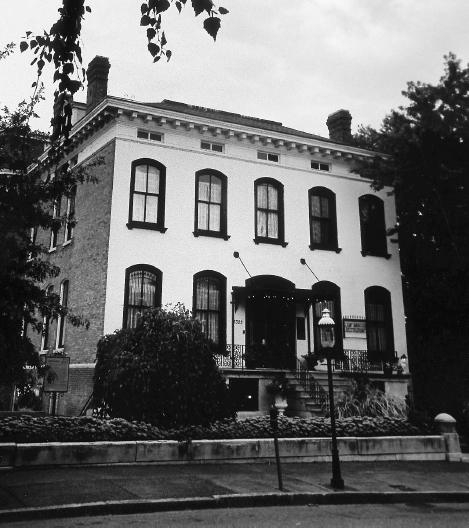
Violent death within the Lemp Mansion is believed to be responsible for making this B&B the most haunted spot in St. Louis. (Leslie Rule)
He certainly did and soon the arrangements were made.
Anita Dytuco and her daughter, twenty-two-year-old Amy, picked me up at the airport. We went out for dinner and they told me they had picked up the key and later dropped their overnight bags off at the Lemp Mansion. “I turned on all the lights downstairs as a test,” said Amy, explaining that many have reported that lights at the mansion turn off and on by themselves.
Sure enough, when we arrived at the big house we found that the lights had been turned off in two rooms. “Someone could be playing a trick on us,” I said as I flipped the switches back on.
But Amy was scared. She followed tentatively as we explored. The thirty-three-room mansion boasts high ceilings, impossibly tall doorways, ornate antique fixtures, and vintage decor. The street level and the basement serve as the restaurant, while the third floor and part of the attic house overnight guests.
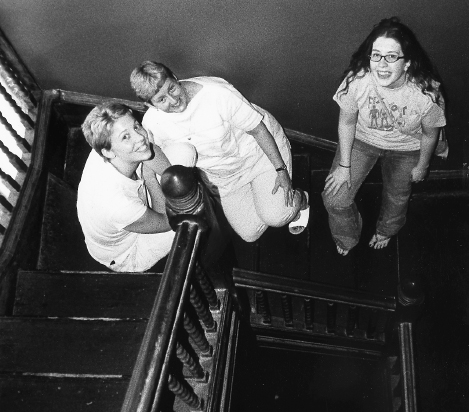
(Left to right) Amy Dytuco, Anita Dytuco, and Bonnie Kleiss pause on the stairway at the Lemp Mansion. Before their visit was over, two of these women would encounter ghosts. (Leslie Rule)
It took some urging for us to convince Amy to explore the attic. Armed with flashlights, we crept up the narrow back staircase, once used by servants, past the attic’s renovated area, down a long hallway, and into a dark cramped space. It was in this hot, stuffy place that the help had lived. While the Lemp family occupied the opulent, spacious rooms below, the servants’ quarters were divided into closet-sized spaces with tiny floor-level windows.
The legend of the Monkey Boy began decades earlier when neighbors whispered that they had seen an ape-like child peering at them from the small attic windows. A rumor spread that Billy Lemp, a married grandson of founder Adam Lemp, had romanced a maid and that the unfortunate child was a result of the forbidden union. The boy was exiled forever to the attic.
It really wasn’t a very scary idea. It was sad.
Our attic expedition yielded nothing exciting. The batteries in our flashlights went prematurely dead as we were exploring—a common phenomenon in haunted sites—and we fumbled our way out. Only one of our trio was to have a paranormal experience before the adventure was over, but it would not be until dawn’s soft light embraced the mansion.
As for the Monkey Boy, he did not appear. Was there such a child? Many have searched for documentation of his existence but proof has yet to be found. The reputedly most haunted mansion in St. Louis, however, has no shortage of tragic stories to feed its ghost legend.
The story begins in the mid–nineteenth century when the city’s natural underground caverns enticed German brewers who found them perfect for refrigeration. Adam Lemp built his empire above a long, rambling cave, which eventually connected the lager beer brewery to the family home.
The beer business boomed and the Lemps’ fortune was made.
In 1876, Adam’s son, William J. Lemp, moved his wife, Julia, and six children into the big Italianate structure. The kids were all under the age of ten and the huge home’s halls must have rung with laughter as Anna, William junior, Louis, Charles, Frederick, and Hilda frolicked and played. When Edwin was born in 1880 and then Elsa in 1883, the family was complete.
During that ear wealthy children played with Steiff teddy bears, exquisite-faced porcelain dolls, wooden blocks, and marbles and rode straw-stuffed horses on wheels. The Lemp children’s nursery, believed to have been located in the third-floor tower room at the top of the main staircase, was certainly filled with the finest toys. I hope these were happy times for the children, for their lives were later marred by tragedy.
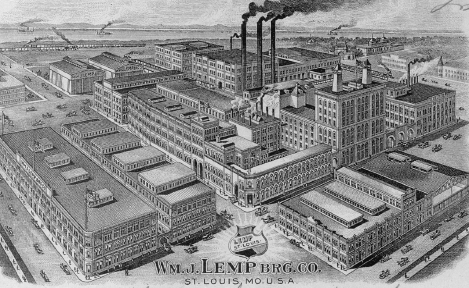
This old postcard depicts the impressive Lemp Brewery when business was booming. Underground tunnels connect it to the Lemp Mansion. (Courtesy of the Ronald Snowden Collection)
Their father set a dark precedent when he took his own life in 1904. He shot himself in the mansion. His son, William J., Jr., followed suit, killing himself in the same room eighteen years later, in 1922. His brother, Charles Lemp, committed suicide in a basement room in 1949.
Though there are four deaths in the Lemp family documented as suicide, one is particularly suspicious. Elsa, the littlest Lemp, born and raised in the Lemp Mansion, died from a “self-inflicted” gunshot wound in 1920.
When she married Thomas Wright, she was the wealthiest single woman in St. Louis. On the tragic day, she was thirty-six years old and lived with him in a grand home on Hortense Place. She had been suffering one of her mysterious bouts of stomach problems the March morning she died.
“She said she was feeling better,” said Thomas Wright.
Was she simply depressed over her illness, as her husband had insisted?
Or was the loss of her only child too much to bear? Baby Patricia had died six years earlier on the day she was born.
Or did someone else have a hand in Elsa’s death?
Thomas had remarried the heiress to the Lemp fortune just eleven days before, after an earlier divorce that kept them separated for about a year.
The St. Louis Dispatch reported that on the morning of March 20, Elsa was in bed when Thomas headed for the shower. When he heard the gunshot he went back to the bedroom and found Elsa wounded. He shouted for help and the maid came running. Elsa died shortly after.
An inquest concluded the death was a suicide. Yet the recent remarriage raised questions. Was the couple happy together? Why would Elsa kill herself when she was feeling better? And what was the cause of her stomach ailment?
If this tragedy unfolded today, the coroner would certainly have looked for poison.
Murder or suicide, it was indeed a troubling death—the kind of death that often results in earthbound spirits. If anyone had an attachment to the Lemp Mansion, it would be Elsa, who was born and raised there.
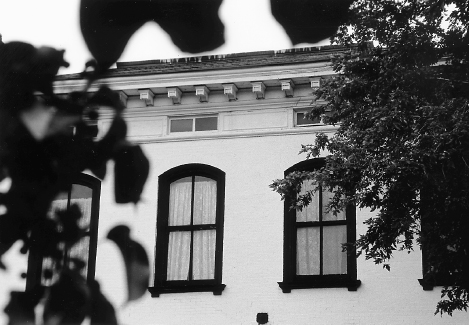
Neighbors said the Monkey Boy peered out of the small attic windows where he was confined. Does his ghost still reside in the attic of the Lemp Mansion? (Leslie Rule)
Both male and female ghosts have been seen at the Lemp Mansion.
A waitress was setting up one morning when she spotted an early customer sitting at one of the tables. “Would you like some coffee?” she asked as she approached him. The man stared into space, ignoring her. A moment later, he vanished.
Was it one of the Williamses, Charles, or Frederick, the favorite son who worked so hard on the family business he dropped dead of heart failure in his late twenties? His heiress, daughter Marion, was later denied a fair share of the Lemp fortune despite the fact Frederick had done more for the business than his siblings. A lawsuit was filed on twelve-year-old Marion’s behalf, but most of her aunts and uncles fought her and won. As a result, Frederick would certainly have reason to be a disgruntled spirit.
As for the female presence, visitors to the Lemp Mansion like to think she is Lillian Handlan, ex-wife of William junior and affectionately known as “The Lavender Lady.” The vivacious socialite was so adored by city folk that crowds met her train whenever she returned from a trip. Dubbed “The Lavender Lady” during the highly publicized divorce trial from Billy Lemp, who cited his wife’s love for the color as one of the reasons for the divorce, Lillian staunchly protested the accusation. The newspaper quoted her as saying in court, “I’ve never worn lavender in my life.”
While fans of the Lemp Mansion count “The Lavender Lady” among the ghosts there, this writer is skeptical. She was not fond of the home, and though she hosted parties there she never actually resided at the mansion and died elsewhere at age seventy-three.
I believe it is Elsa who looks after the Lemp Mansion. The youngest of the Lemp children, she spent her entire childhood there. More than anyone, she would certainly have an attachment to the place.
Another clue strengthens the possibility.
Today the Lemp Mansion is famous for its “Murder Mystery Dinners” where actors add drama to mealtime with first-rate performances of fascinating characters involved in a crime. These actors use the Lemp nursery for their costume room and many report odd occurrences. One actress told me of a sighting that brings poor Elsa to mind. An old-fashioned baby buggy, apparently stored in the nursery, suddenly bolted out of the empty room and shot into the hallway as if invisible hands had pushed it.
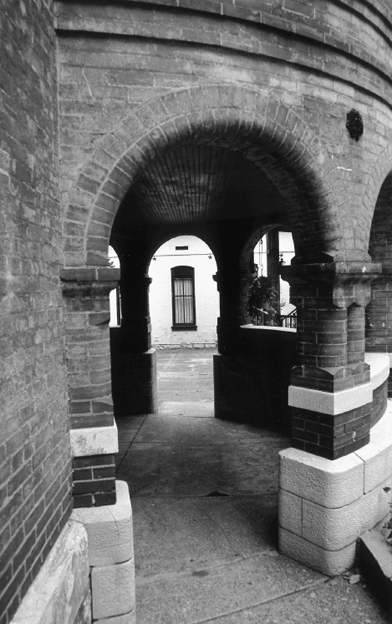
Nooks and crannies and secret tunnels are filled with ghosts at the spooky Lemp Mansion. (Leslie Rule)
Did those ethereal hands belong to Elsa? And did the buggy hold the ghost of her infant daughter Patricia?
It is an interesting question to ponder.
The Pointer family has owned the Lemp Mansion since 1975 and most have experienced odd activity since.
Bonnie Kleiss, Patty Pointer’s college-age niece, will never forget the chill she felt many years ago. “I was about six and my grandma asked me to go upstairs and get some keys for her,” she told me. “Right as I got to the top of the grand staircase, I heard a man’s voice.”
He spoke just one word. “Bonnie.”
“I ran as fast as I could back downstairs and never gave an explanation as to why I didn’t get the keys. I never told anyone in my family about what I had heard.”
Bonnie showed up to stay at the Lemp Mansion on my second day there, and it was then that she confided in me about her experience with the disembodied voice. Later, when I was back home, I received an e-mail from her. It had happened again!
This time she was in bed in the Charles Lemp Suite. As she was drifting off to sleep, a young man’s voice intruded on her slumber. “The difference between this one and the one I heard years ago was that this time it was more playful, ‘Bohh-nniee,’ like it was calling out to me. When I first heard this, it was stated more matter-of-factly.”
It was almost as if the ghost had heard Bonnie tell me the story and was teasing her.
Though the ghosts of the Lemp Mansion didn’t speak to me, they were in a talkative mode during my stay, for Bonnie wasn’t the only one who heard them.
Sweet Amy Dytuco, the terrified member of our little slumber party, also heard from a Lemp ghost! She was so scared that she slept cuddled up to her mother in the big bed in the lovely Lavender Suite. “I couldn’t sleep all night,” she confessed. And then, just as the night was dissolving, a kind female voice whispered, “It’s going to be all right.” The words were gentle and loving and so soothing that Amy was swept into a peaceful sleep.
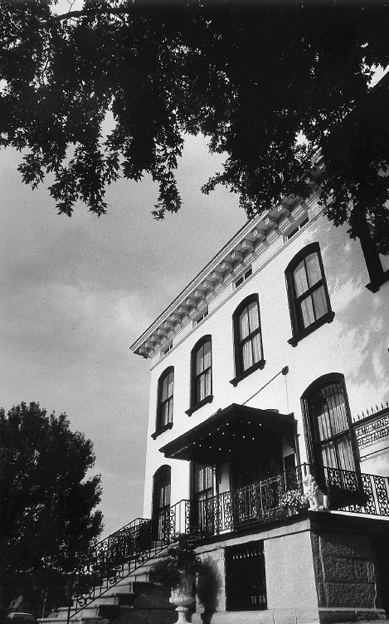
The Lemp Mansion in St. Louis, Missouri, has converted many ghost skeptics to believers. (Leslie Rule)
Who spoke to Amy? It wasn’t Anita. She was fast asleep.
As I pored over the guest books signed by past Lemp guests, I noted a recurrent theme. Guests had recorded many of their paranormal experiences. Furniture was inexplicably moved. “A toilet screamed.” (Perhaps that one wasn’t paranormal but a plumbing problem!) Lights were turned off and on. Apparitions were seen.
And there, recorded in ballpoint pen, was an experience so similar to Amy’s that I caught my breath. A man wrote that he had spent a night in the Lavender Suite and because of emotional turmoil could not sleep. Late into the night, a kind spirit spoke to him. “It’s going to be okay.”
And just as Amy had, the troubled man felt an instant peace and finally fell asleep.
Elsa.
Who else could it be? No one, of course, knows for sure, but Elsa Lemp Wright has my vote. If you visit the Lemp Mansion, say hello to her for me!
____________________________________________
THE LEMP MANSION
3322 DEMENIL PLACE
ST. LOUIS, MO 63118
(314) 644-8024
Ivy House Inn
A city called Casper is sure to have its share of ghosts! The Ivy House Inn is a favorite haunt for visitors to the area. When Tom and Kathy Johnson bought the 1916 Cape Cod house and proceeded to turn it into a bed-and-breakfast, they soon realized previous tenants had not left! During renovation, boards flew across the room, objects inexplicably vanished, and the cord to a drill unplugged and floated in the air.
Guests and family members alike have seen the ghost of Mrs. White, the previous owner, who died at ninety-three. She has been spotted walking in the hallway, and once Eric, the couple’s teenage son, saw her in his room. Mrs. White materialized, appearing as vivid and as solid as a live human being. He watched, startled, as the old woman powdered her face before vanishing.
Other sightings include Mrs. White’s Siamese cat, and a man in a flannel shirt who carries a board.
The Johnsons host an annual Haunted Slumber Party and report that during the event “presences have always made themselves known.”
____________________________________________
IVY HOUSE INN
815 SOUTH ASH STREET
CASPER, WY 82601
(307) 265-0974
Hickory Grove Inn
The Greek Revival–styled farmhouse overlooking Ostego Lake was purchased by the Curpier family as an abandoned property in 1999. Abandoned?
Not exactly!
“We think there are many ghosts here,” admitted owner Marie Curpier, who suspected the Cooperstown, New York, property was haunted from the first moment she saw it. “I knew instantly something was there.”
“We don’t know exactly when the house was built,” explained Marie. “The earliest date we have of its existence is 1830, though it is possible it is over two hundred years old.”
The charming house with the wood-beamed ceilings, fieldstone fireplace, and huge inviting front porch was long known as Hickory Grove Inn, a favorite lakeside inn and restaurant, before Matthew and Marie Curpier turned it into a B&B. It is the restaurant spirits that first made their presence known late one freezing January night when Marie and Matthew were sleeping. “I heard a man yawning,” said Marie. “It was so loud, it woke me up.” The sound emanated from the living room below, which had at one time housed the eatery. “There is no insulation between the floors. You could hear a pin drop.”
“At first we thought someone had broken in,” explained Marie. The noise escalated and the couple huddled together, listening to the clatter of silverware. “It was as if a busboy was shaking a big cup of silverware,” said Marie, who was baffled by the noise. “There was no silverware in that room!”
The clamor included the clanking of dishes, stomping, and drawers banging. “It continued for forty-five minutes and we finally decided to leave.”
The Curpiers bundled up and hurried to their car. A soft frosting of snow coated the ground and as they sat shivering in the driveway, Matthew decided to check around the house. He circled the house and found no footsteps in the snow.
Their intruders were not human—at least not living humans.
The Curpiers are no longer afraid. “I put my foot down and told the ghosts that they must respect our family,” Marie told me, insisting that the spirits are amicable.
Their pranks are harmless. The washer and dryer sometimes turn themselves off and on all night. A shower once turned itself off repeatedly while a guest was using it. Doors slam by themselves and lights go on and off on their own.
Who are the ghosts that haunt the Hickory Grove Inn?
A two-century-old house has plenty of time to gather ghostly inhabitants. Marie wonders if the naughty spirits might belong to the very first family to reside there. “There’s a graveyard on the hill behind the house,” she said. “The family had thirteen children and some of them died young.”
____________________________________________
HICKORY GROVE INN BED AND BREAKFAST
6855 STATE HIGHWAY 80
COOPERSTOWN, NY 13326
(607) 547-1313
Thornewood Castle
An imposing mansion turned bed-and-breakfast in Lakewood, Washington, counts three resident ghosts—including that of a small child who is seen standing beside the nearly lake. When guests spot the little one as they look out their windows, they run to report their concern for the child. The owners smile sadly and shake their heads. The child drowned decades ago.
Many people have prayed for the tiny spirit and believe that the child “went to heaven” and it is simply a place memory left behind.
Castle owners Wayne and Deanna Robinson point to another place memory frequently experienced there.
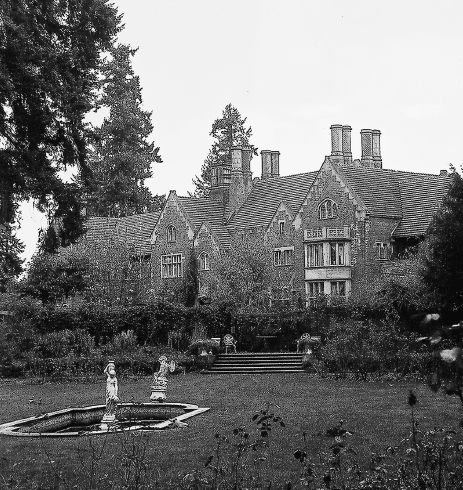
The haunted Thornewood Castle so impressed horror writer Stephen King that he used it for the movie set for his miniseries Rose Red. (Leslie Rule)
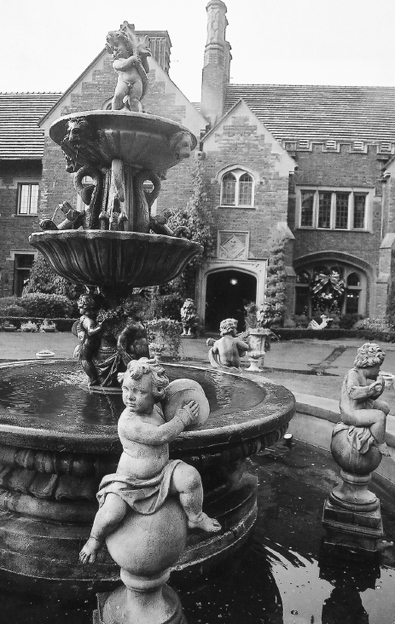
Who knows who lurks in the shadows of the Thornewood Castle? This Lakewood, Washington, bed-and-breakfast is famous as a haunted hot spot. (Leslie Rule)
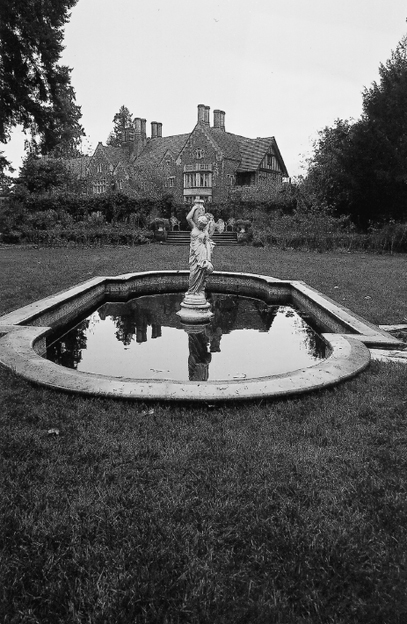
The ghost of a little girl is sometimes seen wandering by the water near the Thornewood Castle. Those in the know say that the child drowned decades ago. (Leslie Rule)
The Thornewood Castle is named for Chester Thorne, who designed his fifty-four-room dream home in the early 1900s to resemble an old English estate. One of the ghosts seen there is thought to be Chester’s wife, Anna Hoxie Thorne, who died on January 28, 1954, at the age of eighty-seven.
“In Anna’s suite, three different brides have seen the spirit of an elderly woman,” said Deanna. “Each time the ghost was seen, the brides were standing before the mirror, looking at themselves in their wedding gowns.” The ghost sat on the window seat, watching them.
Other paranormal activity includes glass inexplicably shattering and the recorded voice of a little girl singing caught on tape.
____________________________________________
Reservations are Required to visit the Thornewood Castle.
THORNEWOOD CASTLE INN AND GARDENS
8601 NORTH THORNE LANE S.W.
LAKEWOOD, WA 98498
(253) 584-4393
Oak Alley Plantation
Oak Alley Plantation is a majestic historic estate named for its enormous oaks, which flank the path leading to the antebellum mansion. Planted in the early 1700s, the native trees thrived, creating an “alley” of oaks so visually appealing they’ve attracted filmmakers for decades. Parts of Bette Davis’s 1964 classic thriller Hush … Hush, Sweet Charlotte were filmed outside the grand mansion.
Visitors can take a tour of the mansion, dine in the estate’s restaurant, or—if they are brave enough—stay in one of the cottages on the grounds in a B&B package.
Some say they’ve seen “the lady in black.” Legend has it that she is the ghost of a lady who had an unfortunate accident on the plantation. Trying to thwart the unwanted advances of an inebriated Romeo, the frightened girl ran from him. She tumbled down the stairs and cut her leg so badly that it was amputated and buried on the grounds.
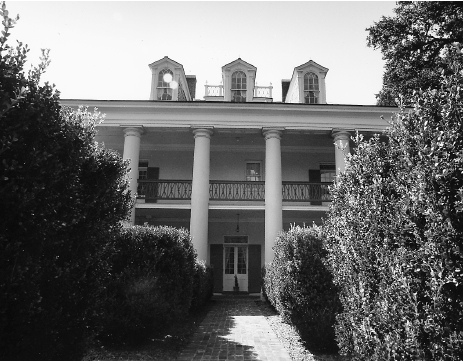
The ghost of a restless young girl is said to search the grounds of the Oak Alley Plantation for something she wants back. (Leslie Rule)
When her lonely form is seen roaming the estate, some surmise that she is looking for her missing leg.
Paranormal activity is frequently reported there—such as the time that thirty-five tourists witnessed a candlestick fly across a room during a tour.
____________________________________________
OAK VALLEY PLANTATION, RESTAURANT & INN
3645 HIGHWAY 18 (GREAT RIVER ROAD)
VACHERIE, LA 70090
(225) 265-2151
(800) 44ALLEY
The Victorian Rose
The Victorian Rose. What a perfectly lovely name for a bed-and-breakfast!
The name is so perfect that at least a dozen other proprietors across America have chosen it for their B&Bs. These other establishments might be wonderful in their own ways, but the Victorian Rose in Ventura, California, is extraordinary. It is housed in a beautiful 1880s church with a classic bell tower and a ninety-six-foot-tall steeple.
The ceilings soar and the stained-glass windows throw a palette of richly colored light on the sweet-faced cherubs and angels that adorn the interior.
Owners Richard and Nona Bogatch devoted two years to restoring the church to a welcoming place that would leave their guests awestruck. While their guests are indeed amazed, it is not just the beauty of the place that astonishes them. Sometimes it is the ghosts.
Richard has had countless reports from guests who have seen the spirits who share his home. “We never ask guests if they’ve seen a ghost,” he told me, explaining that they wait until the guests come down for breakfast and bring it up themselves. “If they’ve seen something, they’ll let us know.”
Often stunned visitors sip their morning coffee, eyes wide, as they describe their encounters with “a man of the cloth.”
The ghostly minister seems to look after the guests. “He tucks them in and strokes their hair,” Richard confided, and explained that visitors regard them more as guardian angels than ghosts.
Actually, there may be two minister spirits, as the clergy ghosts have been given two different descriptions. One rarely seen ghost is bald, while the other has hair. Both wear the traditional collar. It could, of course, be one spirit appearing at times as he looked when young and other times as he was when he’d aged.
“This was originally a Methodist church,” said Richard. Later it was a Baptist church before a religious sect occupied the building.
Sometimes a minister’s apparition materializes in the mirror; other times he is seen standing over a bed, smiling benignly at a startled guest.
While Richard has never actually seen a ghost, he has had some odd experiences, including the time he was making a bed. A pillow flew out of the armoire and sailed past him across the room. Was it a member of the clergy who instigated the pillow fight, or perhaps someone else trying to catch his attention?
While the ministers’ ghosts are fascinating subjects, there is another soul there that the living still mourn for. She, too, is a sweet spirit but likely is restless. Her life was taken from her long before she was ready.
She has been patient for over two decades, waiting for justice. If you too, dear reader, will also be patient, her shocking story will unfold in the next chapter.
____________________________________________
THE VICTORIAN ROSE
896 EAST MAIN STREET
VENTURA, CA 93001
(805) 641-1888